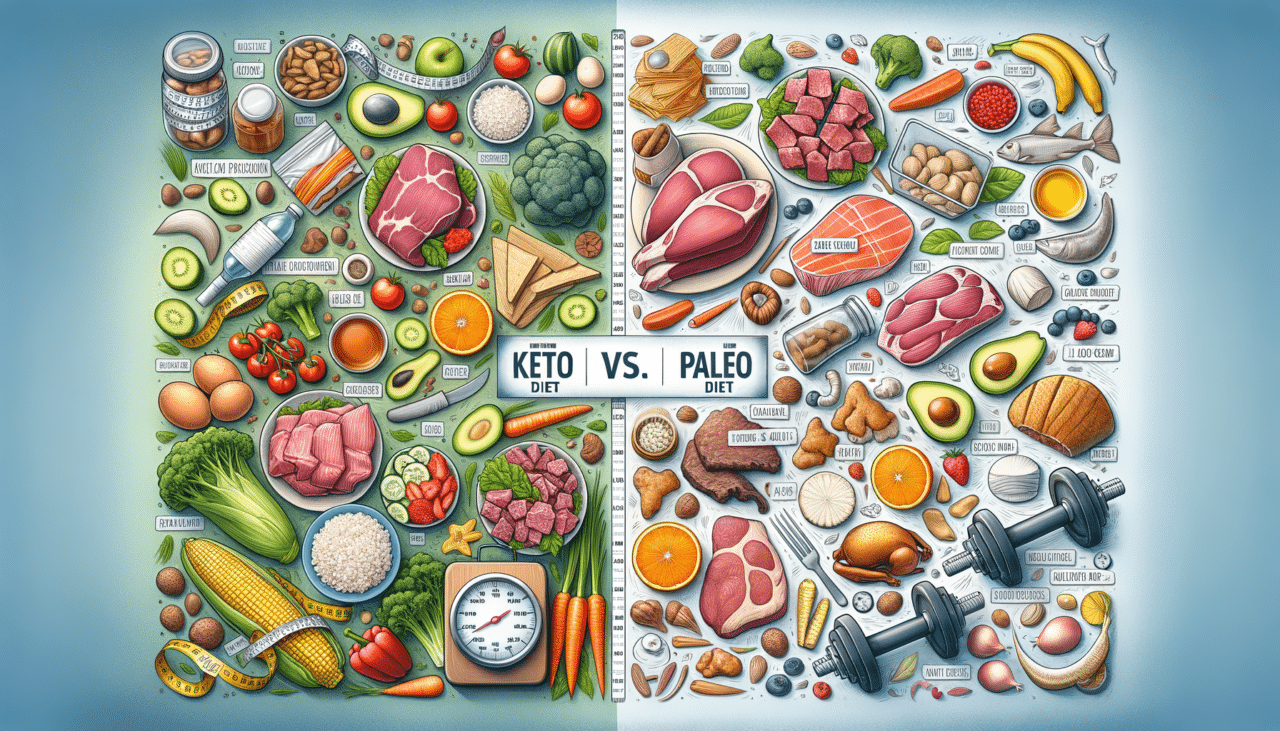In the ever-evolving world of nutrition and dieting, two popular dietary approaches have captured the attention of health enthusiasts and lifestyle changers alike: the Keto Diet and the Paleo Diet. Both diets advocate a return to more natural eating habits, but they do so in distinct ways. This article will delve into a detailed comparison of the Keto Diet and the Paleo Diet, exploring their characteristics, benefits, and potential downsides to help you decide which might be the better fit for your health goals.
Understanding the Keto Diet
Characteristics of the Keto Diet
- High-Fat, Low-Carb: The Keto Diet is characterized by high fat intake, moderate protein, and very low carbohydrates. Typically, the macro breakdown is about 70-80% fats, 10-20% protein, and 5-10% carbohydrates.
- Induces Ketosis: The primary goal is to enter a state of ketosis, where the body burns fat for fuel instead of carbohydrates.
- Restricted Foods: It limits foods high in carbs, such as grains, sugars, legumes, rice, potatoes, candy, juice, and even most fruits.
- Favored Foods: Encourages consumption of fatty foods like oils, butter, avocado, meats, and low-carb vegetables.
Benefits of the Keto Diet
- Weight Loss: Many people experience rapid weight loss due to the body’s increased ability to burn fat.
- Improved Blood Sugar Control: Can be beneficial for those with type 2 diabetes or insulin resistance.
- Enhanced Mental Clarity and Focus: Some report increased cognitive function while in ketosis.
Downsides of the Keto Diet
- Keto Flu: Initial transition can cause fatigue, headache, nausea, and irritability.
- Nutrient Deficiencies: Potential lack of vitamins and minerals due to restricted food groups.
- Sustainability: Some find the diet difficult to maintain long-term.
Understanding the Paleo Diet
Characteristics of the Paleo Diet
- Whole Foods Focus: Emphasizes consumption of whole, unprocessed foods that were presumably available to our Paleolithic ancestors.
- Macronutrient Flexibility: Does not prescribe specific macronutrient ratios, allowing for more flexibility.
- Restricted Foods: Eliminates processed foods, grains, legumes, and dairy.
- Favored Foods: Encourages meats, fish, eggs, vegetables, fruits, nuts, and seeds.
Benefits of the Paleo Diet
- Clean Eating: Promotes a diet rich in nutrients from whole foods.
- Improved Digestion: By eliminating processed foods and certain grains, many experience reduced bloating and better digestion.
- Weight Management: Can lead to weight loss due to reduced calorie intake and higher protein consumption.
Downsides of the Paleo Diet
- Elimination of Food Groups: Cutting out grains and dairy can lead to nutrient gaps.
- Cost: Fresh and organic produce and meats can be more expensive than processed foods.
- Variety: Limited food choices may lead to boredom or difficulty dining out.
Comparative Table: Keto Diet vs. Paleo Diet
| Feature | Keto Diet | Paleo Diet |
|---|---|---|
| Primary Focus | High-fat, low-carb for ketosis | Whole foods, mimicking ancestral diet |
| Macronutrient Ratio | ~70-80% fat, 10-20% protein, 5-10% carbs | Flexible, no strict macronutrient ratio |
| Foods to Avoid | Grains, sugars, legumes, starchy veggies | Processed foods, grains, legumes, dairy |
| Foods to Include | High-fat meats, oils, low-carb veggies | Meats, fish, fruits, vegetables, nuts |
| Health Benefits | Weight loss, improved blood sugar, mental clarity | Clean eating, better digestion, weight management |
| Potential Downsides | Keto flu, nutrient deficiencies, sustainability | Nutrient gaps, cost, limited variety |
Conclusion
Both the Keto Diet and the Paleo Diet offer unique approaches to eating that can lead to improved health and weight management. The Keto Diet may be suitable for those looking to rapidly lose weight and improve blood sugar levels, while the Paleo Diet is ideal for individuals prioritizing whole foods and a clean eating lifestyle. As with any diet, it’s essential to consider your personal health goals, lifestyle, and dietary preferences. Consulting with a healthcare provider or nutritionist can also provide valuable guidance tailored to your specific needs.

Comments (0)
There are no comments here yet, you can be the first!